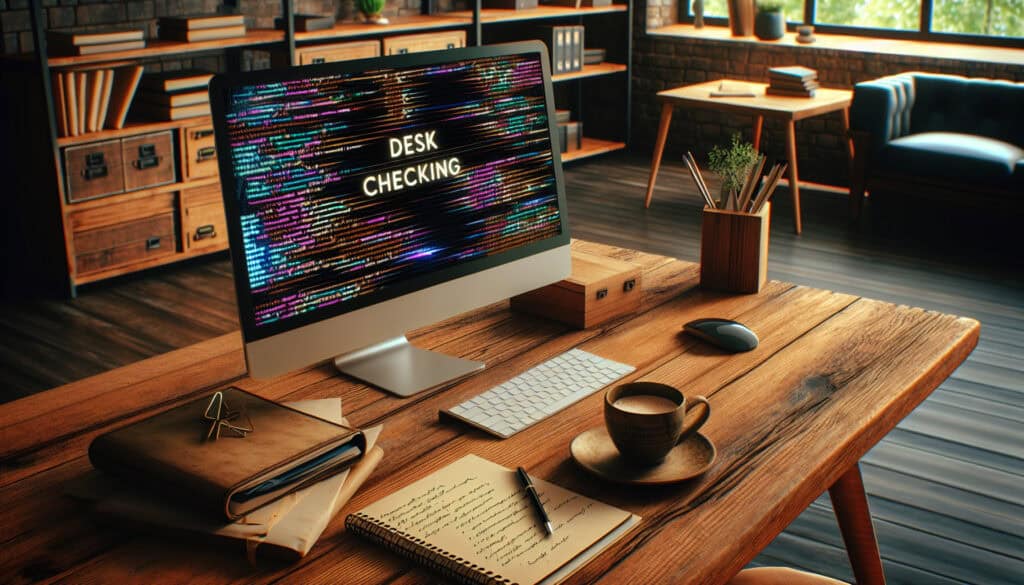An informal, manual process of reviewing one’s own source code or logic before it is compiled or executed.
- Methodologies: Engineering, Product Design, Project Management
Desk Checking

Desk Checking
- Agile Methodology, Continuous Improvement, Error Prevention, Quality Assurance, Quality Control, Software Engineering, Software Testing, Validation, Verification
Objective:
How it’s used:
- A developer sits at their desk and mentally walks through the logic of their code, line by line, to spot errors. It is the most basic form of code review.
Pros
- Is simple, quick, and requires no special tools; helps developers catch simple mistakes before they affect others.
Cons
- It is easy for developers to overlook their own errors due to familiarity with the code; it is not a substitute for a formal peer review or systematic testing.
Categories:
- Engineering, Quality
Best for:
- A developer performing a manual, mental run-through of their own code to catch obvious errors.
Desk Checking is often employed in software development, particularly during the design and testing phases of a project, where developers meticulously review their own code to identify logical flaws or typographical errors before deploying the product. This technique not only serves individual developers but can also be effectively implemented in collaborative environments where team members engage in peer reviews. In industries such as finance, aerospace, and healthcare, where precision is paramount, the practice of Desk Checking becomes even more significant as a preemptive measure against costly errors or system failures. Participants typically include software engineers, quality assurance testers, and technical leads who can contribute different perspectives during the code verification process. The application of this methodology doesn’t require elaborate tools or platforms, making it an accessible practice in both established companies and startups, especially in agile development settings. Desk Checking also promotes a culture of accountability, encouraging developers to take ownership of their code by mentally rehearsing its execution, which can lead to more robust and reliable software solutions. Encouraging this practice early in the development cycle can save time and resources, thus enhancing project efficiency and ensuring the overall quality of the final product.
Key steps of this methodology
- Read each line of code carefully, visualizing its execution.
- Identify and mentally track variable values as the code runs.
- Check conditional statements and loops for logical errors.
- Verify that function calls and their parameters are correct.
- Look out for off-by-one errors in iterations or index handling.
- Consider edge cases and how the code handles them.
- Check for unused variables or redundant code.
- Evaluate the code's flow and structure for readability.
- Reflect on consistency in naming conventions and formatting.
- Mentally replay scenarios to ensure expected outcomes occur.
Pro Tips
- Focus on boundary conditions and edge cases during your mental walkthrough to ensure robustness against unexpected inputs.
- Incorporate peer feedback into your desk checking by verbalizing your logic to a colleague, which can surface hidden assumptions.
- Document your desk-checking thought process for future reference; this can be invaluable for recognizing recurring patterns in errors.
To read and compare several methodologies, we recommend the
> Extensive Methodologies Repository <
together with the 400+ other methodologies.
Your comments on this methodology or additional info are welcome on the comment section below ↓ , so as any engineering-related ideas or links.
Historical Context
1828
1850
1854
1854
1911
1928
1950
1827
1848
1850
1854
1895
1914
1943
1970
(if date is unknown or not relevant, e.g. "fluid mechanics", a rounded estimation of its notable emergence is provided)















Related Posts
Musculoskeletal Discomfort Questionnaires
Multivariate Testing (MVT)
Multiple Regression Analysis
Motion Capture Systems
MoSCoW Method
Mood’s Median Test